|
In my personal reminiscences in the article Old New Guinea Photographs, Part Two, I said that would bethe final part. Anyone who has drank beer with a Territorian (the New Guinea or the Northern type) knows that the last one is not necessarily so. So, by popular demand, with many nostalgia buffs coming out of the woodwork, here is Part Three. No. 3 is not so personal. These lapun (old) TPNG buffs are from all walks of life: kiaps, nurses, pilots, flight hostesses, aircraft engineers, former plantation owners, bag snatchers (some now airline managers), school teachers, ex-missionaries, miners, crocodile shooters and various business people.
Being accused of living in the past is pekpek bilong bulmakau. This sentiment is from those who were not there. Being proud of one’s achievements, of working hard, enjoying life in a wild and beautiful country known as the Land of the Unexpected, being part of adventures, meeting great characters, observing history, seeing unusual sights aplenty, experiencing danger, helping the natives advance into the 20th century, appreciating their differences and general good nature was a unique experience, not easily forgotten.
Even dealing with the thieves (stilman) and the more serious criminals (raskols) was something that most expatriates took in their stride (with some ingenious innovations and remedies). Raskols have now upped the ante to include armed robbery and frequent murder.
I have been encouraged by the response of many TPNG expatriates who were aviators, some that I have not seen for 45 years (there are no good-byes in flying). They recalled their TPNG time with sincere appreciation, flying around the highlands and islands in foul weather, being allowed an amazing amount of freedom to do what is best, with common sense, at such a young age. They all loved the old TPNG days. They furnished me with some of their old coloured slides and Kodachrome photographs to use. I greatly appreciate this courtesy. Their names appear on the credits, the rest are my own photos. Some of these old time bush pilots now have a lot of flight time in Boeing 747s and many are retired. They still fondly remember their TPNG Cessna 185 days.
So, from one (of the many) who has had the privilege and pleasure of flying some wonderful characters from TPNG’s history around the skies of Papua and New Guinea—one who has frightened the best and highest ranking—I ask you to enjoy another trip back to taim bipor. For those not in the loop, this means Time before Independence.
 |
|
Lambom Island, New Ireland, Anzac Day, 1964. Kiap John Brady officiates. The immense responsiblity heaped on Kiaps was unbelievable. Especially for those so young: John is just 20 years of age here. Kiaps were: the district administrator, patrol officer, commissioned policeman, magistrate and gaoler, they conducted elections, were basic (sometimes emergency) medical and dental men and conducted surveys. They built roads, aerodromes and bridges. To John’s left (in peaked cap) is the Luluai, Tondabe, who was the most feared, most powerful man around this area. He was a puripuri man (traditional magic) and his word was final. Brady said the Luluai really listened to the Kiaps and Tondabe was totally on Australia’s side. The Luluai remembered the atrocities of the Japanese military in WW2 all too vividly. Photo: John Brady. |
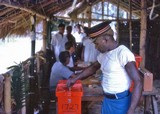 |
|
A Tul Tul votes.Hilalon village, Namatanai, New Ireland, 1964. The Tul Tul was second in command to the Government appointed Chief (Luluai). He kicked arse when the Luluai told him who to kick. An unusual procedure in TPNG days was Assisted Voting in local elections. With most villagers being totally illiterate, the voter was asked (in pidgin) which of the candidates they would like to vote for. If a photo was available, the villager would point at their favourite on the electoral form. Without a picture, it was verbal. He/she was then directed where to put their mark on the voting form. This now seems wide open to serious fraud, but the Kiaps have advised me that everyone was honest and the system worked. It would certainly never work in Australia. Photo: John Brady. |
 |
|
Cessna 336 at Karimui, 1966. My first twin. Kiap Mike Bell was in command here at this time. The Push-pull was easy to fly and was generally reliable. When heavily loaded, the resultant high nose attitude as you squashed along, meant not being able to see forward. Weaving on the climb was SOP to see the mountains. Later they developed a dangerous tendency for shedding a rear propeller blade and cutting through a tail boom. Unhealthy and most scary. |
 |
|
Kalabusman and their sarips, Kerowagi 1966. Prisoners cutting grass with a long blade. Tough justice and hard work, as can be seen here. |
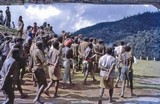 |
|
Returning a recently deceased local man home. Keglsugl, 1966. In the Territory of Papua and New Guinea, the natives did not wish to die away from their own ples (place or home). It was standard procedure, when someone was dying in hospital, to fly them home. Many died during the flight, as was the case here. After shutting down the engine, I opened the rear cargo doors and got out of the way. The mourners descended on the aircraft, wailing and ululating loudly, then took their dead wantok away. Pilot John Crowther, on his second day in TPNG, was stuck in the RH seat and was terrified by the crowd. I regret not briefing him and for leaving him on his Pat Malone. He had almost stopped shaking by the time the mourners carried the departed away, as shown here. |
 |
|
Goroka airport, 1966. The Captain was Don Johnston, Narromine trained and a Cudal man. It was Don who convinced me to learn to fly. Don was originally a crop duster (Cessna 180s) in the late 50s with Max Hazelton at Toogong and Cudal.
|
 |
|
Boeing B17 Flying Fortress, Lae, 1967. A wet morning take-off. The French Navy visits and overnights. On the RH horizon is the aerodrome beacon on Hospital Hill: it is not a blemish on the photo. |
 |
|
Native village near the township of Bwagaoia on Misima Island. In 1967, I was on a four day election tour with ex-Kiap John Stuntz, flying to many small islands. One night we had a big kaikai and drink-up at this village. Organised by Alby Munt, it was memorable because it was attended by millions of glowing Fireflies. A magic night. John was running for the position of local member Milne Bay Province. He was well prepared. At islands with no airfield, we dropped native tobacco (brus) and election papers (with his photo thereupon) in Hiri Motu and the local lingo from the aircraft’s storm window. He won. |
 |
|
Guasopa airport, Woodlark Island, 1967. Electioneering with John Stuntz, I flew Bob Gibbes’ Twin Comanche, VH-RHG. John is sitting in the crowd, talking politics and handing out tobacco. He had a stentorian voice, with no need for a microphone or loud hailer. Some unfair souls even suggested he was reviving the Cargo Cult by giving the natives gifts. Especially from the air.
|
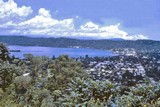 |
|
Rabaul and Simpson Harbour, New Britain, looking north, 1968. Some study of Rabaul’s history is time well spent. From the colonial days of the German administration, Queen Emma Coe, WW1 and WW2 and the devastating volcanic eruptions—there’s plenty of interesting variety. In 1967, I was here and was shaving early one morning. Noticing the mirror shaking, I said to myself “I didn’t have that much to drink last night”. It was one of Rabaul’s frequent gurias (earthquakes). |
 |
|
SDA Mission Cessna 185 landing at Ambunti, on the Sepik River, 1968. The uncouth, the irreligious and the atheists called missionaries the Bible Bashers. At this time, many religions owned a lot of land in New Guinea (plantations, etc.) and many natives worked for the love of God—only. No money. While many criticised the churches for such business practices (the bulk of the money was sent overseas to the various church HOs), there were many very genuine and committed religious people who really helped the natives. At Independence, many missionaries were summarily dismissed and expelled from the country. Some of those Nuns had worked in Papua and New Guinea for over forty years. Many were in a state of shock at such “ungrateful” treatment. |
 |
|
Lae aerodrome, 1968. Note; no Macair buildings or hangar as yet. The old Guinea Airways hangar is still standing (close to the water’s edge, above the runway’s piano keys). An aerodrome with a fascinating history. Photo: Gary Bull.
|
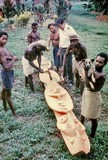 |
|
Wood carvers at Ambunti, on the Sepik River, 1968. GCS seen here wearing the Macair green, before the Hitler Youth uniform issue. It was the evil Talair pilots who used this derogatory term to describe our khaki and brown uniforms. (They were heavy drinkers, you know.) |
 |
|
Graham Carson's Malekolan plantation on Ambitle Island, Feni Island Group, New Ireland, NE of Rabaul. A beautiful place. |
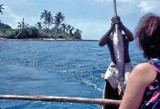 |
|
Denise Kelly at Malekolan, 1969. That’s an oar, not a weapon. Enjoying an outrigger trip between the two islands: from Babase Island (with the aerodrome) over to Ambitle Island (Carson’s plantation). Both the plantation and the aerodrome were called Malekolan. |
 |
|
Downwind leg at Wau in a Baron, 1969. |
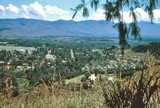 |
|
Goroka from the Lookout, 1970. A very pleasant place to live |
 |
|
Three varieties of arsegrass. Mendi aerodrome, 1970. Very effective, but only when walking, for swishing flies away from one’s Khyber Pass. Photo: Mike Condon. |
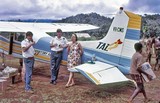 |
|
Bosavi airfield, 1970. Morning tea: Pilots Peter Howell and Mike Condon, with the Missionary’s wife. Any aircraft in TPNG that carried CM in the registration was an ex or a current Catholic Mission aircraft. Look at the skimpy laplaps on the fellows at the extreme right of the photo. Cannibalism was practiced in this area until just before this. Photo: Mike Condon. |
 |
|
The Sepik River and Manam Island, the volcano smoking away. The Ramu River empties at the coast, just to the RH side of Manum. Photo: Mike Condon. |
 |
|
Above Goroka, at the Lookout, 1970. Three dreamers, three mates. GCS (Sypho), John Absolem and Ian Rowles. |
 |
|
A Mitsubishi Zero fighter at Gasmata, 1970. I would love to have a dozen of these (in this condition) nowadays. They would be worth a dollar or two. Photo: Ross Shepherd. |
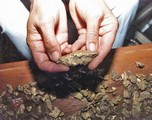 |
|
New Guinea gold from the Highlands. Photo: Maski Wari. |
 |
|
The Pilatus Porter, a great STOL performer. I had a sad Porter flight, ca. 1971, one of those return the dying home flights. The Meri had just been discharged from the hospital. No stretcher was used and she was able to be seated behind the load of freight. On arrival at Yalumet airstrip, I went to assist my three passengers out of the rear bench seat. The woman was dead, sitting beside her grief-stricken husband, leaning against him. The bush couple’s son, about three years of age, was standing in front of his father’s knees. He did not know his mother was gone. Without communications, we were unexpected. Unusually, no wailing crowd met us. We laid her on the grass, beside the aircraft. Such experiences are never forgotten. |
 |
|
Squeaky Mouse at Menyamya airfield, ca. 1971. Photo: Gary Bull. |
 |
|
Marawaka aerodrome, during Police Commissioner’s visit, 1971. Photo: Mike Condon. |
 |
|
Rabaraba airfield, Milne Bay area, with a Cessna 185 landing. Most unusual and eye-catching hills around here. Rabaraba was right on the coast and a delightful spot. Photo: Gary Bull. |
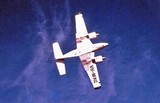 |
|
A high speed beat up, after a low run. No names, no pack drill. Only information, long dispela poto; it was on the coast and the Kiap (the photographer) was looking straight up. Some pilots had the effrontery to call a fast low run down an airstrip an "overshoot after an approach". An approach in a Baron at 200 knots? Note the full aileron deflection. |
 |
|
Port Moresby Harbour, 1971. Photo: Gary Bull. |
 |
|
Pilatus Porter. Fuel load, unloading drums at Omkalai, Chimbu Province. The Wahgi river is at the bottom of the ravine, top LH side of the photo. Photo: Gary Bull. |
 |
|
“Not looking too good towards Mount Hagen. I’ll sit it out at Minj.” |
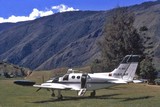 |
|
Macair Cessna 402A at Tapini, ca. 1973. Photo: Gary Bull. |
 |
|
The Kabwum Trading Company Cessna 185, Lae, 1974, with Ian Rowles. Shortly after this photo was taken, Ian died in a bad weather crash in this aircraft. Photo: Richard Leahy. |
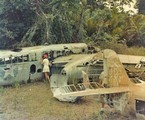 |
|
Tadji airfield, near Aitape, north coast of New Guinea, 1972. A WW2 B-25 Mitchell and a P-39 Aircobra. Photo: Richard Leahy. |
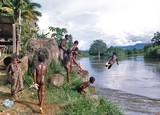 |
|
Kids swimming in the Karawari river, a tributary of the mighty Sepik River. Photo: Richard Leahy. |
|




































